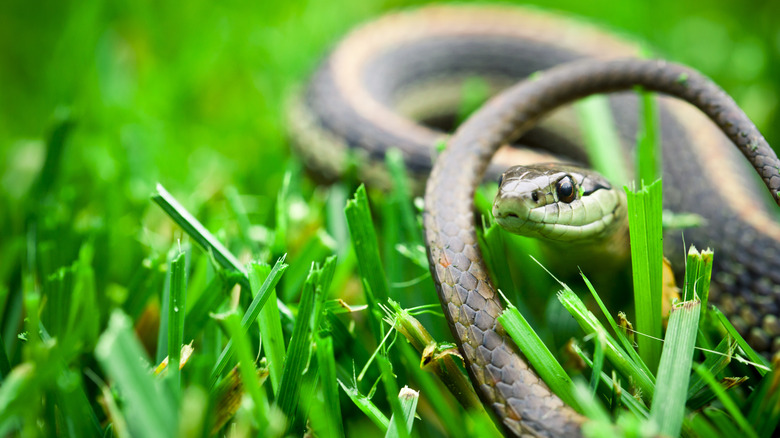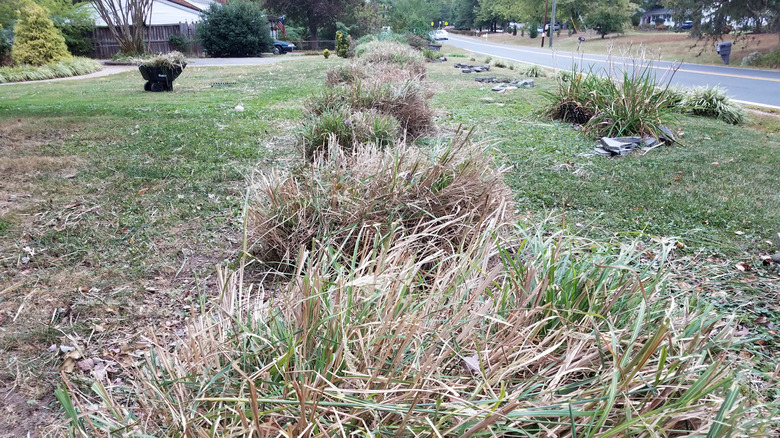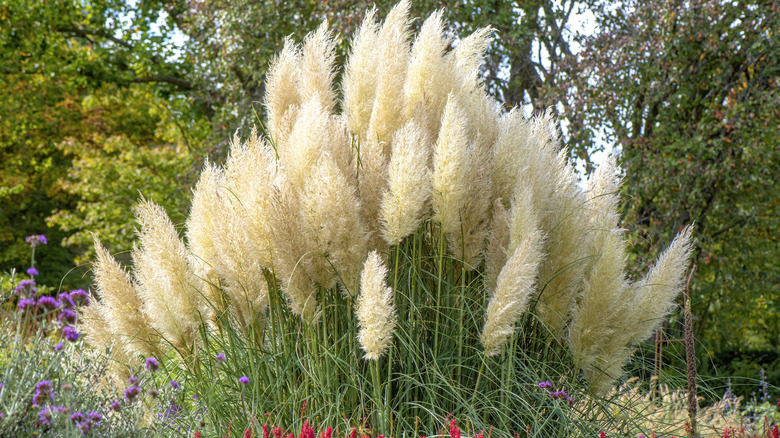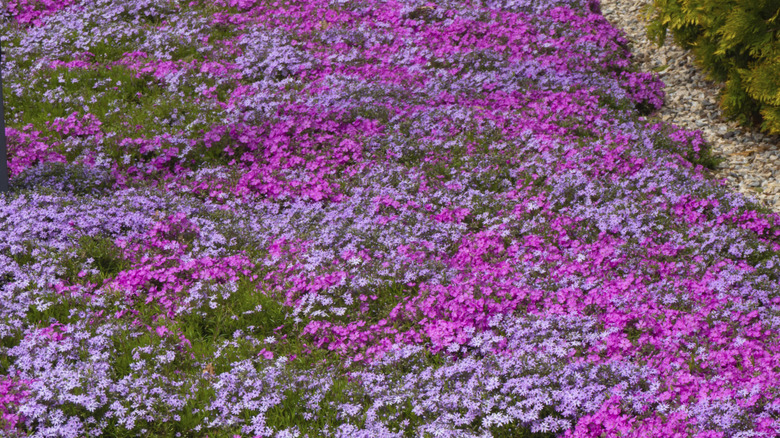This Plant Is A Snake Magnet In Your Yard, You've Been Warned
Snakes love to hide in taller grass where they can wait and stalk their prey, as well as hide from birds who may be hunting them. Most often, the grass in backyard lawns doesn't get tall enough to actually create enough visual protection like this, which is why you may find them hiding in holes or under logs instead of in your lawn. However, if you have ornamental grasses, especially pampas grass, you've got the ideal hiding place. Even though this type of ornamental grass has gained popularity in its beautiful, showy display, you'll want to look for signs of snakes, including shed skin, feces, and snake holes in your yard.
Native to South America, pampas grass (Cortaderia selloana) can reach as high as 10 feet, and patches can easily fill your flower beds since they can spread more than 6 feet wide. They're most notable for their thick flowers that have a dramatic white, silver, or pink color and a feather-like appearance to them. This grass brings height to any landscape design.
However, said height, coupled with the larger and thicker base of this plant, makes for a good hiding place for snakes. If you're planning to use it in your landscaping, it's a good idea to keep it controlled and to use a few extra steps to minimize a snake's desire to call this its new home.
Properly caring for pampas grass can minimize snake risks
You don't have to give up using this stunning ornamental plant in your landscaping just because you want to keep snakes at bay, but you do need to know how to successfully care for pampas grass. Start with a good pruning during the spring months. Pampas grass grows quickly and typically doesn't need a lot of hands-on care during the growing season, but to curb its rapid growth, give it a hard prune during early spring. Go ahead and trim the plant right down to the same level as the ground. That may seem drastic, but it will help kickstart the growth cycle without overwhelming your yard. Wearing gloves and a shirt with long sleeves, you can use heavy-duty shears or a power pruner to get the pruning job done.
Don't make the mistake of burning the stubs, though. Not only is it bad for the pampas grass, it's a wildfire risk as well. Remove any clumps or sprouts that have popped up outside of the main area, as this is how the plant spreads. If you keep it more controlled it can minimize the snake-like habitat. Without enough foliage to hide under, the snakes are likely to move on.
Make the area less friendly to snakes
Once this ornamental grass begins growing, there are few extra tips to minimize snakes and pests. The goal should always be the same: remove the habitat risks, eliminate any food source, and bring in more natural predators to target the unwanted snakes. Starting with a smaller, cleaned-up grass plant is the first step. Make sure to remove any lumber or other debris from your yard as well.
Work to eliminate food sources from the area, including the presence of rodents (attracted by bird feeders in your yard, luring in snakes after them). Pampas grass does best in well-draining soil, which is less likely to attract snakes who prefer moist environments for their nests — so improve the drainage conditions around your plant. Don't use any mulch, wood chips, or other piles of debris that may attract snakes. Keep the lawn mowed around your pampas grass to eliminate further hiding spots.
If you're really worried about snakes near your ornamental grass, consider adding a snake-proof fence around the exterior of your property. This will keep snakes out without requiring you to trim back the beautiful foliage and plumes created by pampas grass. Even then, it's always a good idea to look carefully before you stick your hand into these plants.
Alternatives to pampas grass
If you want to do away with your pampas grass altogether, there are a few alternatives that may not attract snakes as much, due to the fact that they stay low to the ground without forming dense mats. Consider groundcover plants instead of the typical ornamental grasses. Creeping phlox, for example, is a beautiful, dense groundcover that won't grow more than 6 inches tall and grows in USDA zones 3 through 9. Just make sure you don't confuse phlox for an invasive weed like dame's rocket. Another alternative is Texas frogfruit, which also only grows up to 6 inches and has similar growing conditions to pampas grass.
If your heart is set on an ornamental grass, you may want to try planting dwarf versions of these beauties. Dwarf mondo grass can not only handle foot traffic, but can fill out those sparse areas in your lawn that struggle to maintain grass thanks to its ability to thrive in shady areas. Throughout the year, it may produce little berries or small violet blooms. It can handle zones 5b through 11. Meanwhile, dwarf blue fescue adds color to your yard all year long and can form small, dense mounds of grass around 8 to 12 inches tall — far shorter than pampas grass' 10-foot height.



